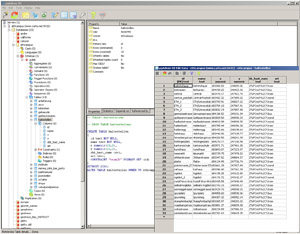1.1.4. Databases
A database is an organized collection of information. The information is collected within tables which consist of rows and lines. There exist various database products:
|
 Example of a Database Software (PgAdmin III) Example of a Database Software (PgAdmin III) |
The open source databases are getting serious competitors to the
commercial databases. In many cases it is easier and cheaper to use Open Source
products compared to the more complex and expensive commercial ones.
Typically, for a given database, there is a structural
description (also known as schema) of the type of information held in that
database. The schema describes the objects that are represented in the database,
and the relationships among them.
Databases are optimized
for quick access and manipulation. Typically, the data of a database is created,
modified and retrieved with SQL (Structured Query Language).
If you are interested in the functions and syntax of SQL, have a look at the W3C Tutorial "Learn SQL"
Advantages
The advantages of databases are:
- High performance,
- Quick and easy accessed,
- Standardized access through SQL,
- Can manage huge amounts of data,
- Multi-User support, Access control,
- The data within a database is structured,
- Can store different data types.
Disadvantages
The disadvantages are that the database product
needs to be installed and there is also a need in administration skills for the
software. The installation and the creation of the data tables is time consuming
because there are several steps to create the final tables and their structure
(creation of table, definition of attributes within the tables, filling the
tables with data, etc.).
Databases are not suitable for the storage of
a huge amount of binary files.
Usage Scenario
Databases are used for bigger until huge datasets which require an efficient data management.
